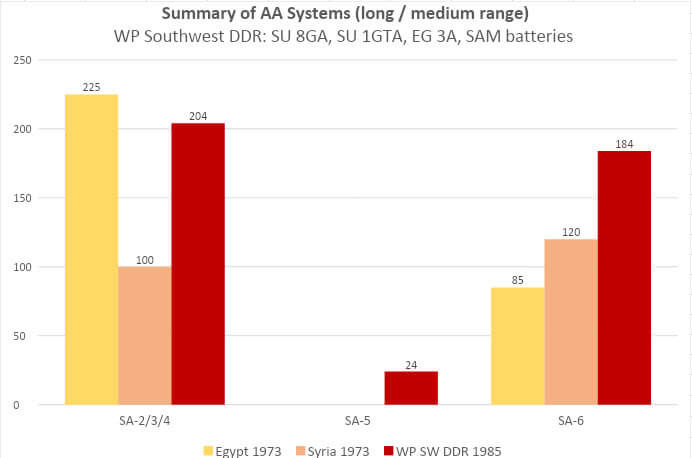
Much thanks to Designers for sending information along that support their design theory, ideas, mechanics and ultimately the CRT!
Lets look at 1973 data as a precursor to evolutions in thought around AA and the effectiveness of aircraft. The chart above is:
- A comparison of the 1973 Syria / Egypt AA defense with the Warsaw Pact AA defenses in front of US V Corps sector. Takes into account only SAM, both fixed and mobile, and used to demonstrate the extreme lethality of the area for any NATO CAS mission.
The Arab Israeli war showed some fascinating results in one of the first true larger scale air wars in the modern jet age since Vietnam.
The Israeli Air Force (350 – 400 aircraft) initially tried to focus on Close Air Support [CAS], but quickly switched to a SEAD [SAM suppression] campaign after it became clear that the loss ratio was unbearable. In the end Israel lost between 100 and 120 aircraft, half of them during the first 48 hours while trying to execute CAS missions to support the ground combat.
This concept is well expressed by some declarations by David Ivry, second in command of Israel Air Forces during the Yom Kippur War:
“To Ivry, the IAF’s loss of effectiveness was devastating. “At the end of the war,” he said, “we managed to come up with quite an impressive victory,” but Israel’s military leaders had “a very bad feeling” about the fact that the F-4 was “not successful against SAM batteries.” SAM belts restricted the ability of the IAF to interdict an invading army. Surface-to-air missiles could also shelter batteries of short-range surface-to-surface missiles like the SS-21, which would be capable of holding Israeli territory at risk of attack.
As Ivry saw it, airpower’s role in future wars had been placed in doubt. The 1973 war left Israel–not to mention other Western air forces–with the fear that fighters might no longer be able to gain air superiority against an integrated air defense. One such skeptic was Ezer Weizman, a former commander of the IAF. Ivry recalled Weizman’s stated view as “the wing of the fighter plane was broken by the SAM.”
Clearly, the IAF’s freedom to operate in future battles depended on its finding a way to rapidly and systematically take out stationary or mobile SAMs. In Ivry’s view, the main lesson of 1973 was simple: “We have to find an answer to the SAM batteries.”
Soviet fronts range anywhere from 200km to 300kms. Within that space the numbers of SA-6, SA-9 and then version 4 and 3 are staggering. Fabriizio was kind enough so share what the 8th Combined Guards Army and 1st Tank Army would deploy:
- 140x SA-6 launchers (4x MRD, 3x TD)
- 112x SA-9 launchers (4x MRD, 3x TD)
- 81x SA-4 launchers (3x SAM Brigades)
- 60x SA-3 launchers (lower estimate on 1x Missile Brigade, fixed SAMs twin launchers)
If you recall my prior post I shared the percent chance to hit for various quality aspects. This is a function of ‘density’ or unit count of SA-,6’s 9’s etc per Division, Brigade etc and of course capability to use them effectively. The density of coverage was staggering. Which for me raises questions and validates my original question. What has changed in the period 1985-1989. that Soviet capability appears to be so degraded? why in Red Strike with 2 day turn cycles are there LESS aircraft losses for NATO than in Under an Iron Sky with [EDIT] 48 hour turns or two day turns turns?
A small correction….1985:UAIS has 48 hours turns
fixed…doah.